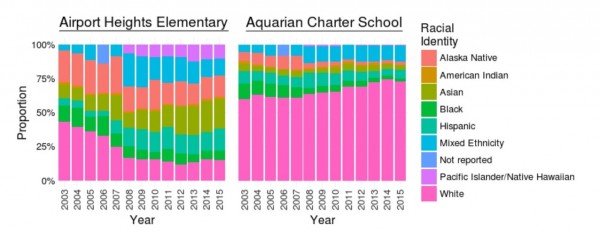
It’s school lottery time in Anchorage. That means parents who may want to opt out of their neighborhood school are considering optional and charter school programs across the district. But at least one neighborhood school principal says charter schools and neighborhood schools aren’t necessarily so different. Parents took school tours to find out.
Last year was really stressful for Sara Lopez when she was trying to find a kindergarten for her son.
“There’s a lot of pressure to get your kid in the right school and you want them to go to the right school,” she said. “And I think our neighborhood school is really good, too. And all of my friends who have kids the same age like, ‘Are you doing this tour? Are doing this?’ It was a lot to take in at one time.”
Lopez’s neighborhood school is Lake Hood, but she decided they preferred Aquarian Charter School for their son because it offers creativity, individualized teaching, and quarterly exploration days with themes like Star Wars and CSI. She and her husband Franky reconfirmed their decision when they joined a dozen other parents during a school tour last month.
“They’re only little for so long,” she said. “And why not let them do things like Jedi explorations and the Star Wars stuff and throw paper airplanes in the hallway?”
“And have Princess Leia walk right past you,” added Franky as a teacher in costume went down the hallway.
So they decided to play the lottery. Last year, families filed more than 5,600 applications for students from all grades to go to charter schools, optional programs, or get zone exemptions. The Lopez’s didn’t make it into any alternative options for kindergarten, but their older son is first on the waiting list for next year’s first grade class at Aquarian. One hundred and fifty other kids are trying, too, in part because test scores for Aquarian and other optional programs are consistently higher than for the district as a whole.
But not all families have the ability to compete for spots at the school. Charter schools don’t provide any transportation, so parents have to be able to get there kids there every day. As a result, charter schools have far fewer students who are considered economically disadvantaged. They also have fewer students of color.
Airport Heights Elementary School principal Mike Webb said the charter schools are drawing kids away from his neighborhood school. About 40 percent of the students in his boundary area transferred out this school year.
“The parents in our neighborhood very often are looking for charter schools to go to, if they have the mobility to go to them,” he explained. “And my response to those parents is that I get that you’re looking for what’s best for your kids, but why are you not knocking on the door and saying, ‘Hey, make this a better school, make it fit to what the needs of my kids are.'”
On a recent Tuesday, Webb took me on a private tour because no parents showed up for the Visit Our Schools event. We walked down the halls and glanced into the classrooms through new windows.
“So really the whole idea that everybody’s learning and that’s what this place is for becomes more visible when you have windows in the wall,” he said. “So it’s kinda cool.”
The renovation also created new spaces for collaboration. Webb said he and his staff have restructured the school week so teachers can work together more and students can try new types of lessons. It’s a weekly, hour-long version of Aquarian’s quarterly exploration blocks.
Webb said they’re trying to engage students beyond the basics, just like charter schools, so kids can see different types of careers and hobbies. The school is also trying to engage more parents. They’re offering translators during community conversations because many of the parents don’t speak English as a first language and dropping fees for joining the PTA.
“These parents are very invested in their children and want what’s best for them. I think part of the challenge is that because of the language barriers, and in some cases the cultural barriers, they’re just not sure how to do that. And navigating the complex educational system as we have is daunting to many of our parents.”
Test scores at Airport Heights are low compared to other schools. Parents don’t volunteer as many hours. But Webb said he’s trying to change that by learning from other schools and leveraging what his neighborhood can offer.

“One thing that we have here that a lot of those schools don’t have is the level of diversity is huge. And taking the strength of that and really highlighting that in what we do is both a challenge and a cornerstone of a great school. Especially given our global economy and all the things going on in the world.”
But Webb said it will take innovation and parent buy-in, the same things that help make Aquarian successful.
The Anchorage School District lottery is open until March 24.
Anne Hillman is the healthy communities editor at Alaska Public Media and a host of Hometown, Alaska. Reach her at ahillman@alaskapublic.org. Read more about Anne here.





